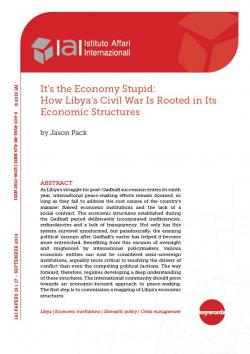It's the Economy Stupid: How Libya's Civil War Is Rooted in Its Economic Structures
As Libya’s struggle for post-Qadhafi succession enters its ninth year, international peace-making efforts remain doomed, so long as they fail to address the root causes of the country’s malaise: flawed economic institutions and the lack of a social contract. The economic structures established during the Qadhafi period deliberately incorporated inefficiencies, redundancies and a lack of transparency. Not only has this system survived unreformed, but paradoxically, the ensuing political vacuum after Qadhafi’s ouster has helped it become more entrenched. Benefiting from this vacuum of oversight and ringfenced by international policymakers, various economic entities can now be considered semi-sovereign institutions, arguably more critical to resolving the drivers of conflict than even the competing political factions. The way forward, therefore, requires developing a deep understanding of these structures. The international community should pivot towards an economic-focused approach to peace-making. The first step is to commission a mapping of Libya’s economic structures.
-
Details
Rome, IAI, September 2019, 27 p. -
In:
-
Issue
19|17 -
ISBN/ISSN/DOI:
978-88-9368-109-4
Introduction
1. Libya has institutions – They are just the wrong ones
1.1 Deliberately partisan, but directly powerful political institutions
1.2 Semi-independent vs independent economic institutions
1.3 Attempts to modernise Libya’s economy only made things worse
2. Enter the Libyan revolutionaries
2.1 Inheriting an economy without a blueprint
2.2 After Qadhafi, the power of the semi-independents increased
2.3 The rise of the semi-sovereign economic institutions
3. Sovereignty in post-Qadhafi Libya
3.1 Semi-sovereign not sovereign
4. The pressing need for transparency
4.1 What is known about the semi-sovereigns?
4.2 What is known about the economic logic of the fighting?
5. What the international community can do
Conclusions and the way forward
References



